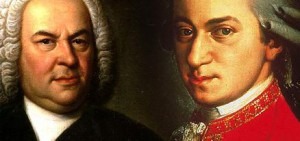 Wolfgang Amadeus Mozart was the undisputed pop star of the 18th century! Numerous composers and musicians arranged his music, and profited handsomely from this indirect association with a superstar. But Mozart himself was also a rather active arranger of works by other composers, most notable Johann Sebastian Bach and George Frideric Handel. During a trip to Bologna, the 14-year-old Wolfgang Amadeus Mozart met the composer and historian Father Giambattista Martini. Martini was considered one of the greatest counterpoint teachers of the eighteenth century. Even Johann Christian Bach, youngest son of Johann Sebastian, had gone to Bologna to study with the Italian master. This meeting proofed rather significant for the young Mozart, since Martini was probably the only Italian at that time who owned a copy of J. S. Bach’s Art of the Fugue. Mozart’s contact with the mastery of the German contrapuntal tradition opened a completely new musical horizon, which he approached via a number of arrangements for String Trio.
Wolfgang Amadeus Mozart was the undisputed pop star of the 18th century! Numerous composers and musicians arranged his music, and profited handsomely from this indirect association with a superstar. But Mozart himself was also a rather active arranger of works by other composers, most notable Johann Sebastian Bach and George Frideric Handel. During a trip to Bologna, the 14-year-old Wolfgang Amadeus Mozart met the composer and historian Father Giambattista Martini. Martini was considered one of the greatest counterpoint teachers of the eighteenth century. Even Johann Christian Bach, youngest son of Johann Sebastian, had gone to Bologna to study with the Italian master. This meeting proofed rather significant for the young Mozart, since Martini was probably the only Italian at that time who owned a copy of J. S. Bach’s Art of the Fugue. Mozart’s contact with the mastery of the German contrapuntal tradition opened a completely new musical horizon, which he approached via a number of arrangements for String Trio.
Johann Sebastian Bach: Prelude No. 5 Fugue No. 5 (after BWV 526) (arr. Wolfgang Amadeus Mozart K. 404a)
By the late 1780s, the music of Bach and Handel was considered seriously antiquarian. And so it was left to Baron Gottfried van Swieten—who penned the libretto for Haydn’s Creation—to keep the old masters alive. In fact, he had one of the biggest private musical manuscript collections in the world. But Swieten not merely collected musical scores, he was also interested in having these works performed as well. To that end, he held regular musical parties in his Vienna residence. And Mozart was a steady guest, reporting “nothing is played but fugues by Handel and Bach.” In 1788, van Swieten commissioned Mozart to fashion an arrangement of Handel’s Acis and Galatea, adopting the work for contemporary Viennese taste.
George Frideric Handel: Acis and Galatea
(arr. Wolfgang Amadeus Mozart, K. 566)
Relying on the classical style of the day, Mozart added second violins, woodwinds, viola, and bassoon parts while re-writing the oboe solos for clarinet. Emphasizing the dynamics and phrasing of the melodic line, Mozart used the German text translation fashioned by van Swieten, and excluded all recitatives. Mozart’s efforts on behalf of Handel have not been well received in the 20th century. The musicologist Paul Henry Lang wrote, “Mozart’s version of Handel is like Pope’s translation of Homer: an excellent work without being a good translation. Mozart’s language is not Handelian, and his personality is far removed from Handel’s.” Mozart, so it is suggested, undertook these arrangements purely for the income. “It was a joyless labor in which Mozart invested a minimum of artistic effort.” Between 1788 and 1790, Mozart fashioned four Handel arrangements for private performances organized by Baron von Swieten. His 1789 arrangement of the Messiah has remained controversial to this day.
George Frideric Handel: Messiah (arr. Wolfgang Amadeus Mozart, K. 572)
Mozart transforms Messiah from a Baroque into a Classical idiom, making changes that fall into a number of basic categories. For one, Mozart cuts two movements entirely, makes significant alterations to a number of recitatives. He also altered the instrumentation, adding flutes, clarinets, horns, and trombones, and composes new parts for oboes, bassoons, trumpets, and timpani. Mozart added a number of performance indications, including dynamic markings, articulations, trills, and tempo indications. Finally, interpretation of musical notation had changed significantly in the half-century between the composition of Messiah and Mozart’s arrangement. As such, we find differences in approach to tempo, the placement and execution of ornaments, and changes in string technique. Although we are looking at a clash between two systems of expression, Mozart was not a translator but a creator who made decisions according to his own criteria. And he certainly transferred the lessons of his Bach and Handel arrangements into his own work.
Wolfgang Amadeus Mozart: Fugue for 2 Keyboards, K. 426
